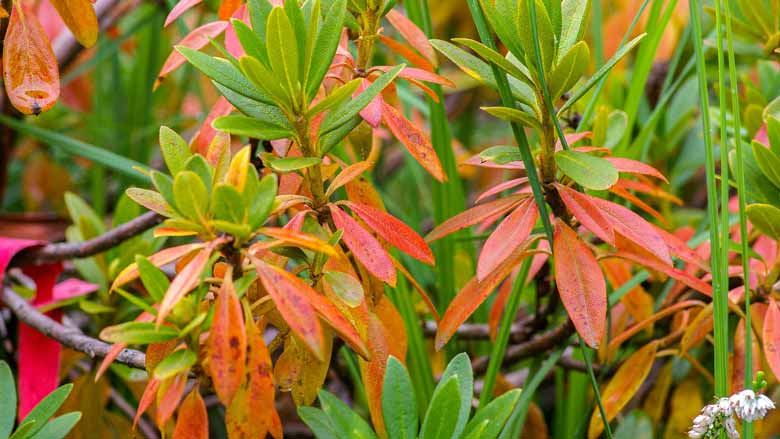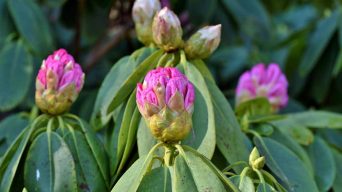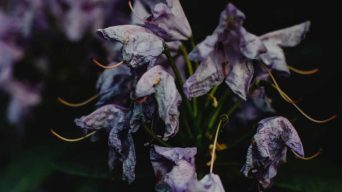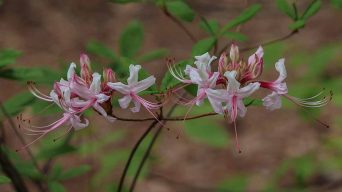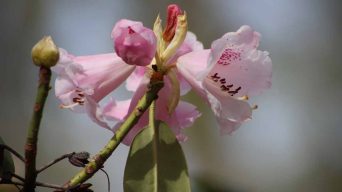Rhododendron are one of the most popular ornamental plants in the world.
They are prized for their large, showy flowers and their ability to thrive in a wide range of climates.
However, rhododendrons can sometimes start to die for no apparent reason.
If your rhododendron is dying, there are several possible causes and solutions.
Why Is My Rhododendron Dying?
There are many reasons why a rhododendron might start to die.
Some of the most common include:
1. Too Much Water
Rhododendrons are native to areas that receive a lot of rainfall.
As a result, they are adapted to getting a lot of water.
However, overwatering can be harmful to rhododendrons.
If the soil around your rhododendron is constantly wet, it can cause the roots to rot.
How To Tell If You Are Overwatering Your Rhododendron
There are a few signs that you might be overwatering your rhododendron.
These include:
- The leaves of your plant are wilting or turning yellow
- The leaves have brown spots
- The stems are soft or mushy
- The flowers are dropping off prematurely
- The soil is soggy or muddy
- Rotten roots
How To Save An Overwatered Rhododendron
If you think you are overwatering your rhododendron plant, the best thing to do is to cut back on watering.
Allow the soil around your plant to dry out completely before watering again.
It is also a good idea to check the drainage of your pot or planting area.
Rhododendrons need well-drained soil to thrive.
If the drainage is poor, you may need to repot your plant in a pot with better drainage or amend the soil around it.
You may also need to adjust your watering schedule.
Water your rhododendron less frequently, but water it deeply when you do.
This will help encourage deep, healthy roots.
2. Too Little Water
While too much water can be harmful to rhododendrons, too little water can also cause problems.
Rhododendrons need a consistent supply of moisture to stay healthy.
If the soil around your plant is allowed to dry out for too long, it can cause the leaves to wilt and the plant to start dying.
How To Tell If You Are Underwatering Your Rhododendron
There are a few signs that you might be underwatering your rhododendron.
These include:
- The leaves of your plant are wilting or turning brown
- The leaves have dry, crispy edges
- The stems are hard or woody
- The flowers are dropping off prematurely
- The plant is not growing as quickly as it should be
How To Save An Underwatered Rhododendron
If you think you are underwatering your rhododendron, the best thing to do is to water it more frequently.
Water your plant deeply until the water starts to run out of the bottom of the pot.
Rhododendrons must be watered about once a week, but more often in hot weather.
Use your finger to test the moisture level of the soil before watering.
It is time to water your plant if it is dry several inches below the surface.
3. Too Much Sunlight
Rhododendrons are native to wooded areas where they receive filtered sunlight.
They do not do well in direct sunlight, and too much sun can scorch your plant’s leaves.
Rhododendron plants need to be in an area that receives partial sun to partial shade.
How To Tell If Your Rhododendron Is Getting Too Much Sunlight
There are a few signs that you might be giving your rhododendron too much sunlight.
These include:
- The leaves have yellow or brown spots
- The leaves are wilting or drooping
- Wrinkled and crispy leaves
- The flowers are faded or dropping off prematurely
- The plant is not growing as quickly as it should be
How To Save A Rhododendron That Is Getting Too Much Sunlight
If you think your rhododendron is getting too much sunlight, the best thing to do is to move it to a shadier location.
An east- or north-facing window is a good spot for rhododendrons. This will help protect your plant from the harsh afternoon sun.
You can also provide shade for your plant by growing it under a tree or planting it in a pot that can be moved indoors or into the shade as needed.
4. Too Little Sunlight
While too much sunlight can harm rhododendrons, too little sunlight can cause problems.
Rhododendrons need a minimum of four hours of sunlight daily to stay healthy.
If your plant is not getting enough sun, it will grow weak and leggy. The rhododendron leaves may also turn yellow or brown.
How To Tell If Your Rhododendron Is Getting Too Little Sunlight
There are a few signs that you might give your rhododendron too little sunlight.
These include:
- The leaves are pale green or yellow
- The rhododendron is leggy and weak-looking
- The leaves are small and unhealthy-looking
- The rhododendron leans toward the light source
- The flowers are small or nonexistent
- The growth is stunted
How To Save A Rhododendron That Is Getting Too Little Sunlight
If you think your rhododendron is not getting enough sunlight, the best thing to do is to move it to a sunnier location.
An east- or north-facing window is a good spot for rhododendrons. This will help ensure that your plant gets enough sunlight each day.
You can also provide additional light for your plant by growing it under a grow light.
5. Nutrient Deficiencies
Rhododendrons need a few essential nutrients to stay healthy. These include nitrogen, phosphorus, and potassium.
Rhododendrons also need other essential nutrients, such as iron, magnesium, and sulfur.
A lack of any of these nutrients can cause problems for your plant.
How To Tell If Your Rhododendron Has A Nutrient Deficiency
There are a few signs that your rhododendron might have a nutrient deficiency.
These include:
- Yellow leaves
- Slow growth
- Poor flowering
- Leaves falling off the plant
- Small leaves
How To Save A Rhododendron With A Nutrient Deficiency
If you think your rhododendron has a nutrient deficiency, the best thing to do is to fertilize your plant.
Use a fertilizer that is high in nitrogen, phosphorus, and potassium.
You can also use a general-purpose fertilizer or a slow-release fertilizer.
Apply the fertilizer according to the package directions.
You can also repot your rhododendron in fresh soil. This will help ensure your plant gets all the nutrients it needs.
6. Root-Bound
Rhododendrons can become root-bound if they are grown in a pot that is too small.
A root-bound plant will have a mass of roots that have filled the pot and begun to circle around the inside of the pot.
This can cause problems for your plant, as the roots will not be able to absorb enough water and nutrients.
How To Tell If Your Rhododendron Is Root-Bound
There are a few signs that your rhododendron might be root-bound.
These include:
- The roots are growing out of the drainage holes in the pot
- The plant is wilting, even when the soil is moist
- The plant is not growing as quickly as it should be
- The leaves are yellow or brown
How To Save A Rhododendron That Is Root-Bound
If you think your rhododendron is root-bound, the best thing to do is to repot your plant.
Choose a pot two or three inches larger than the current pot.
Fill the new pot with fresh, well-draining soil.
Carefully remove your plant from the old pot and place it in the new pot.
Backfill with additional soil as needed.
7. Cold Damage
Rhododendrons are sensitive to cold weather and can be damaged by frost or freezing temperatures.
The plant leaves will turn brown and wilted if exposed to frost.
The flowers will also be damaged by frost and may turn brown or black.
How To Tell If Your Rhododendron Has Cold Damage
There are a few signs that your rhododendron might have cold damage.
These include:
- Brown or black leaves
- Wilted leaves
- Leave that lose their color
- Damaged or dead flowers
- Stunted growth
How To Save A Rhododendron With Cold Damage
If you think your rhododendron has cold damage, the best thing to do is to move your plant indoors.
Place your plant in a sunny location and make sure the temperature does not drop below 60 degrees Fahrenheit.
You can also protect your plant from frost by covering it with a light cloth or placing it in a plastic bag.
8. Hot Weather Damage
Rhododendrons can also be damaged by hot weather.
The leaves of the plant will turn brown and wilted if exposed to too much heat.
The flowers will also be damaged by heat and may turn brown or black.
Rhododendron plants thrive in temperatures that are between 60 and 80 degrees Fahrenheit.
If the temperature gets too hot, the plant will start to stress.
How To Tell If Your Rhododendron Has Hot Weather Damage
There are a few signs that your rhododendron might have hot weather damage.
These include:
- Leaves edges that are brown or black
- Wilted leaves
- Yellow leaves
- Damaged or dead flowers
- Stunted growth
How To Save A Rhododendron With Hot Weather Damage
If you think your rhododendron has hot weather damage, moving your plant to a cooler location is best.
Place your plant in a shady spot and make sure the temperature does not rise above 80 degrees Fahrenheit.
Avoid placing your plant in direct sunlight, which can cause further damage.
You can also mist your plant with water or place a humidifier near your plant to help increase the moisture in the air.
9. Overfertilization
Rhododendrons can be damaged by overfertilization.
This can happen if you use too much fertilizer or apply it too often.
When a rhododendron is overfertilized, the plant’s roots will be burned.
This can cause the leaves to turn yellow or brown.
It can also cause the flowers to be damaged or to fail to bloom.
How To Tell If Your Rhododendron Is Overfertilized
There are a few signs that your rhododendron might be overfertilized.
These include:
- Yellow or wilted lower leaves
- Brown leaf tips or edges
- Roots that are brown or black
- Damaged flowers
- Stunted growth
How To Save An Overfertilized Rhododendron
If you think your rhododendron is overfertilized, the best thing to do is to flush the roots with water.
To do this, water your plant deeply and drain the excess.
You can also remove the plant from its pot and rinse the roots with water.
Once you have rinsed the roots, repot your plant in fresh, well-draining soil.
Don’t fertilize your plant for at least a month, and then only use half the amount of fertilizer you typically use.
10. Pests
Pests can damage rhododendrons.
Common pests that attack rhododendrons include mealybugs, aphids, scale, and whiteflies.
These pests can suck the sap out of the leaves, which can cause the leaves to turn yellow or brown.
The pests can also damage the flowers and cause the plant to produce fewer blooms.
How To Tell If Your Rhododendron Has Pests
There are a few signs that your rhododendron might have pests.
These include:
- Yellow or wilted leaves
- Sticky leaves
- Damaged flowers
- Holes in the leaves
- Whiteflies, aphids, or mealybugs on the leaves
How To Save A Rhododendron With Pests
If you think your rhododendron has pests, you should first check the leaves for signs of pests.
If you see any pests on the leaves, you can remove them by hand. Use a cotton swab dipped in rubbing alcohol to kill the pests.
With aphids, you can also blast them off with a hose.
You can also use insecticidal soap or neem oil to get rid of pests. These products are safe for plants and will not harm people or animals.
Keep your plant healthy and free of stress to prevent pests from attacking your rhododendron.
Pests are attracted to weak and stressed plants.
11. Diseases
Diseases can damage rhododendrons.
Common diseases that attack rhododendrons include root rot, powdery mildew, and leaf spot.
Root rot is caused by too much moisture around the plant’s roots. This can cause the roots to rot and the plant to wilt.
Powdery mildew is a fungal disease that causes white spots on rhododendron leaves.
Leaf spot is a fungal disease that causes brown or black spots on the rhododendron leaves.
How To Tell If Your Rhododendron Has a Disease
There are a few signs that your rhododendron might have a disease.
These include:
- Wilting leaves
- Leaves that are yellow, brown, or black
- White powdery mold on the leaves
- Brown or black spots on the leaves
- Roots that are brown or black
How To Save A Rhododendron With a Disease
If you think your rhododendron has a disease, you should first isolate the plant from other plants.
This will help to prevent the disease from spreading.
Next, remove any affected leaves from the plant.
You can also treat the plant with a fungicide. You can use a natural fungicide like neem oil, or you can use a chemical fungicide.
Be sure to follow the instructions on the label when using any type of fungicide.
To prevent diseases from attacking your rhododendron, make sure to plant your rhododendron in well-draining soil.
You should also avoid overhead watering, as this can spread diseases.
Removing dead leaves or flowers from the plant is also a good idea.
If you see any signs of disease, you should treat the plant as soon as possible.
Final Thoughts
Rhododendrons are beautiful plants that can add color to your garden.
However, rhododendrons can be susceptible to several problems that can cause the plant to die.
The good news is that there are several things you can do to save a dying rhododendron.
The first thing you should do is try to identify the problem.
Once you have identified the problem, you can take steps to fix it.
In general, the best way to prevent problems with rhododendrons is to keep your plant healthy and stress-free.
By following these tips, you can help ensure that your rhododendron stays healthy and blooms for years.

